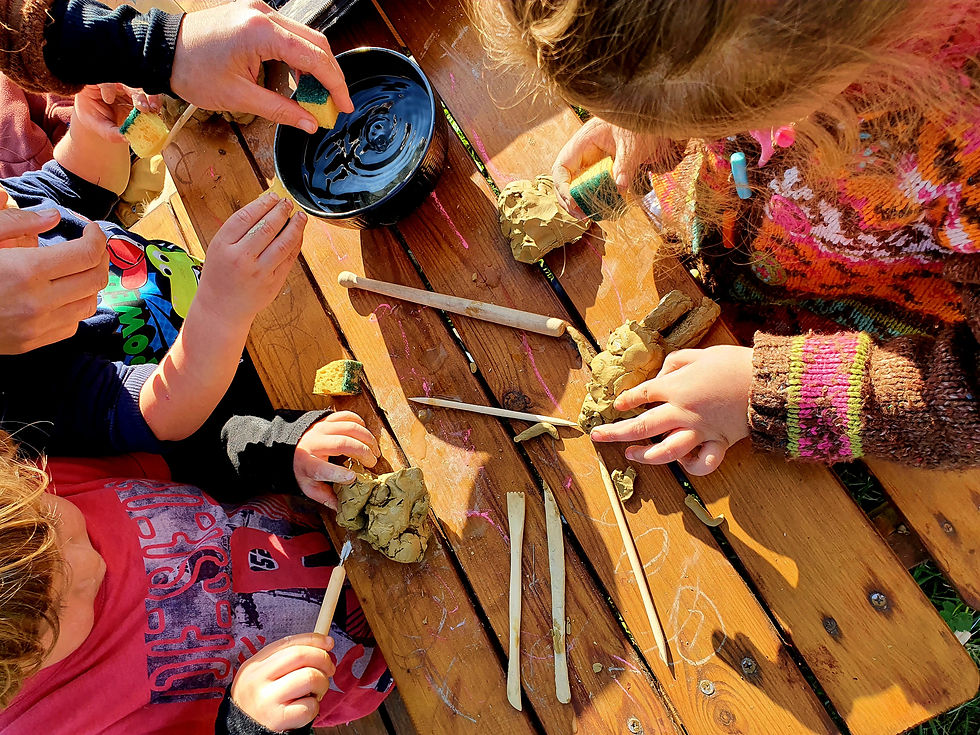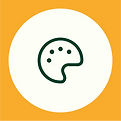
Program
2024/2025
At the Forest School, all students are teachers, and all teachers are students. Parents can also be teachers, as well as the forest brook, the exposed root of an old beech tree, or the mother of a new brood of young hedgehogs, and they can also be students.
We invite all those interested in nature and in sharing knowledge about nature and humanity to join us in this adventure of creating a child-centered space.
Join us and enrich the workshop program with your knowledge, skills, experience, and love.
The most beautifully shared lessons are those learned from the heart.
Program options
The focus of the program is on the needs of the students themselves, spontaneous play, internal motivation, and curiosity, which are addressed through unstructured time—free for exploration and spontaneous learning—and through organized workshop activities with experts in various fields.
The Forest School curriculum is implemented daily, either for half a day or a full day, or once a week during weekly forest gatherings on Wednesdays.
Whole-day
Half-day
8 - 12 / 12 - 16 h
Weekly forest meetings
The program for the 2024/2025 school year is for children approximately aged 4 to 14.
We invite all of you who are interested in nature and sharing knowledge and experiences about nature and humanity to join us in this adventure of creating a place that is child-friendly. The most beautiful lessons are those learned with the heart.
The Forest School starts its activities on September 30, 2024.
The '24/'25 program will run from September 30, 2024, to May 30, 2025.
A day in the
Forest school
The day consists of free time for independent and group play and learning, a morning circle and reflection circle, as well as organized workshops that deepen experiential knowledge and skills.
08:00 - 09:00 Arrival, breakfast, free play
09:30 - 10:00 Morning circle
10:00 - 13:00 Time for activities
13:00 - 14:00 Lunch
14:00 - 15:00 Free play / group activity
15:00 - 16:00 Group clean-up and reflection circle
16:00 Departure









Areas of learning
In the Forest School, learning subjects are not separated from each other. We do not aim solely for the development of specialized knowledge but for a comprehensive understanding of objective human reality.
We believe that children learn better through examples that require knowledge from various fields (mathematics, biology, drawing, dance, etc.).
For instance, while building a birdhouse, we learn about trees, the ecology of the species that will inhabit the birdhouse, the proper use of tools, and how to calculate the size of the entry hole for an adult bird, among other things. In creative classes, the focus and attention may sometimes be on mathematics and logic, physics, chemistry, and biology, and other times on philosophy, history, psychology, sociology, and art.
Modern research blurs the boundaries between natural and social sciences, between nature and society. Where and how are the boundaries established between music and mathematics, between ethics and aesthetics, between psychology and sociology, philosophy and anthropology?
The pedagogical approach of the Forest School develops intellectual skills and knowledge in parallel with the understanding of our emotions and intuition, our cultural patterns, and habits in everyday life.

Self-awareness and awareness of others
The universal awareness that we teach through our pedagogical approach illuminates our inner strengths, voices, and motives that guide our thoughts, feelings, and behaviors.

Movement
By directing energy and attention towards movement, we learn to develop physical abilities and capacities, as well as our talents for sports, music, and other artistic activities.

Maths & Logic
Through mathematical and logical workshops and activities, we develop our brain's capabilities, learn to think, and solve problems both individually and as a team.

Communication
The development of communication helps children understand content and communication in different world languages, with a focus on Serbian, English, Italian, and Spanish. We also explore various forms of nonverbal communication.

Ecology & Permaculture
For the development of self-esteem and respect for others, we need knowledge about the relationships that create the rich living world in nature. Ecology helps us understand the world and nature, ourselves and our place in it, and to live in harmony with that understanding.

Food
From seed to plate
Working in our organic garden provides the opportunity to explore and understand nature, its laws, and relationships. Gardening and horticulture based on permaculture principles respect the cultivation of food according to nature’s principles, which are older than current human methods of growing and producing food.

Practical life excercises
Personal hygiene, the hygiene of our environment, and our relationship with nature and the environment teach us to respect living beings, evolutionary processes, and the relationships that create life.

Arts & Crafts
The creation of artistic content begins with listening and mastering the movements of hands, pencils, brushes, keyboards, and other tools. Drawing, painting, knitting, dancing, singing, and playing music...

Navigating nature
We learn to navigate natural environments using our own skills, knowledge, and available resources. This includes how to build a shelter, safely start and maintain a fire, and find edible and medicinal plants...

Suggested monthly donation
Šumska škola is the project of the non-governmental, non-profit organization 'Creative Network Panonika,' and as such, it does not aim to make a profit. All funds paid for registration fees are directed towards maintaining existing and expanding additional capacities of the Forest School.
It Includes:
-
Maintenance costs of the space
-
Food for participants, facilitators, and educators
(breakfast/snack and lunch) -
Educational materials and tools for activities
-
Occasional visits to nearby natural and cultural places
-
Donations for the work of facilitators
It does not include and is optional:
-
International diploma from the homeschooling academy,
for students aged 6-18 year olds -
Excursions and trips to other locations, theatre visits, exhibitions, museums, concerts, swimming, and other group-interest and possible activities and events
Full-day
35.000 din
300 eur
Half day
23.500 din
200 eur
Weekly meetings
12.000 din
100 eur
-
What does a day at the Forest School look like?We gather at the entrance to the forest or as the excitement slowly spreads among us. Birds are chirping, a gentle breeze moves over the hills, and boots cheerfully seek out puddles. The forest is here, the equipment is ready, and our goal is to ensure the physical and emotional well-being of every member of our group. Before we start, we come together to check how everyone is feeling and what they would like to explore during the day in nature. We introduce new ideas and encourage them to seek our help whenever needed. The forest environment is like a blank canvas, full of textures and materials that enrich the senses and inspire us to explore and learn together. As guides, we have a plan for the day if students request it, but it is equally important for us to encourage them to choose their own path. During this time of exploration and discovery, our role is to provide support when needed, while also encouraging them to face challenges and find meaning in their experiences. Through reflection and conversation, we listen to their stories and acknowledge their emotions. Our day flows naturally, developing through interactions, individual interests, and guidance that introduces new ways to explore the space and relationships within it. Through observation and mentorship, guides recognize how they can shape experiences that will leave a lasting impression while also acknowledging the impact that time has on themselves. Guides carefully allow students to take on challenges, linking these experiences to comprehensive development—whether social, physical, intellectual, communicative, emotional, or spiritual. We conclude our time with reflection, looking back at the experiences and emotions of each group member, sharing insights, and recognizing the uniqueness of each individual. Our aim is for every member of the community to feel their value and to identify ways we can support their personal development and connection with nature and the community.
-
What to wear and what to bring?How to dress your child: As we are outside for a large part of the day, it is important to dress the children according to the weather conditions. In warm days light clothes, in colder multi-layered ones. Dress them in clothes that can get dirty. For winter days: tights/leggings, another pair of pants on the top, short t-shirts and long sleeves, a sweatshirt/sweater and a winter jacket. Warm shoes. Gloves, hat, scarf. In case of rain or snow: waterproof rain/ski clothes, and waterproof shoes, so the little one's can experience being outdoors in all weather conditions without hindrance. What to bring: - Rucksack - a water bottle - change of clothes - spare socks, panties, pants, T-shirt and sweatshirt - house shoes
-
What do children eat and drink at school?School meals include a variety of vegetables, a nutritionally rich lunch, and refreshing, healthy drinks. All food at school is plant-based. For a snack we usually have fresh and dried fruits and vegetables (in season from our garden), nuts, seeds, wholemeal biscuits, chrono bars, homemade wholemeal bread, and fresh spreads... Lunch is prepared by Mama Goga, a lover, and expert in the preparation of balanced, tasty, and varied plant-based food, and meals include soup or broth, main course, whole wheat bread, salad, and dessert. For drinks with meals, we have spring water, homemade teas from Fruška, freshly squeezed juices, smoothies, plant milks, and yogurt (from nuts and seeds).
-
What does the school’s space look like?We spend time on the family estate, in a spacious yard filled with purposefully designed nooks and equipped with educational materials that inspire inner curiosity and invite play, exploration, connection, and natural learning. We also have an indoor space for colder days, within the warm atmosphere of the family home, equipped with educational materials and areas for play, dining, and relaxation. We spend time in the forest of Fruška Gora and visit other interesting natural and social places, so the space (and atmosphere) of the school travels with us wherever we go. :)

